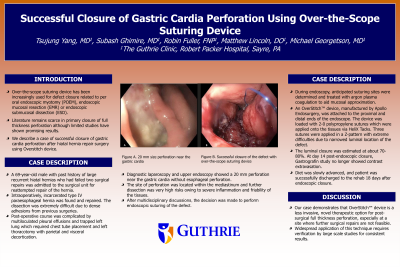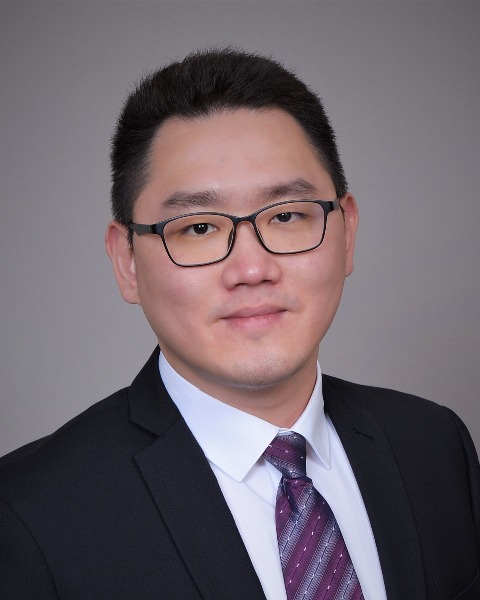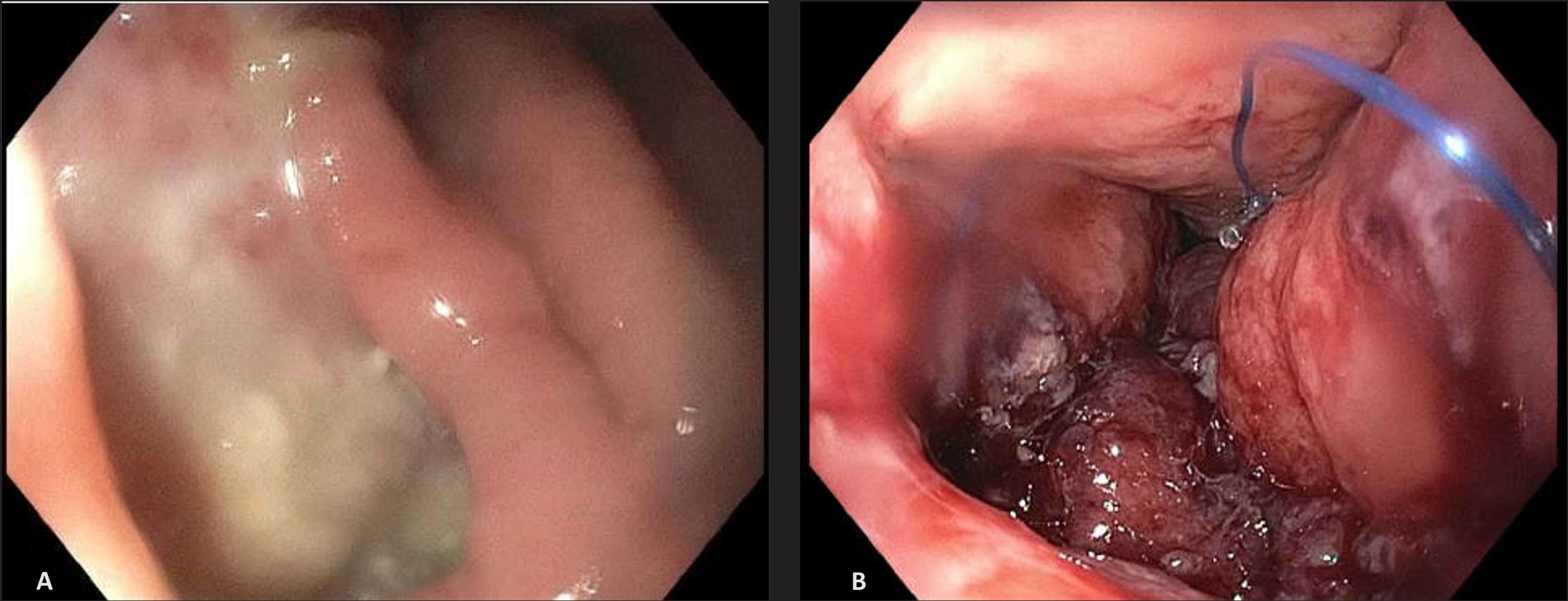Sunday Poster Session
Category: Interventional Endoscopy
P1106 - Successful Closure of Gastric Cardia Perforation using Over-the-scope Suturing Device
Sunday, October 27, 2024
3:30 PM - 7:00 PM ET
Location: Exhibit Hall E

Has Audio

Tsujung Yang, MD
Guthrie Robert Packer Hospital
Sayre, PA
Presenting Author(s)
Tsujung Yang, MD, Subash Ghimire, MD, Robin Fuller, FNP, Matthew Lincoln, DO, Michael Georgetson, MD
Guthrie Robert Packer Hospital, Sayre, PA
Introduction: Over-the-scope suturing device has been increasingly used for defect closure related to per oral endoscopic myotomy (POEM), endoscopic mucosal resection (EMR) or endoscopic submucosal dissection (ESD). Literature remains scarce in primary closure of full thickness perforation although limited studies have shown promising results. We describe a case of successful closure of gastric cardia perforation after hiatal hernia repair surgery using OverstitchTM device.
Case Description/Methods: A 69-year-old male with past history of large recurrent hiatal hernias who had failed two surgical repairs was admitted to the surgical unit for reattempted repair of the hernia. Intraoperatively, incarcerated type IV paraesophageal hernia was found and repaired. The dissection was extremely difficult due to dense adhesions from previous surgeries. Post-operative course was complicated by multiloculated pleural effusions and trapped left lung which required chest tube placement and left thoracotomy with parietal and visceral decortication. Diagnostic laparoscopy and upper endoscopy showed a 20 mm perforation near the gastric cardia without esophageal perforation. The site of perforation was located within the mediastinum and further dissection was very high risks owing to severe inflammation and friability of the tissues. After multidisciplinary discussions, the decision was made to perform endoscopic suturing of the defect. During endoscopy, anticipated suturing sites were determined and treated with argon plasma coagulation to aid mucosal approximation. An OverstitchTM device, manufactured by Apollo Endosurgery, was attached to the proximal and distal ends of the endoscope. The device was loaded with 2-0 polypropylene sutures which were applied onto the tissues via Helix Tacks. Three sutures were applied in a Z-pattern with extreme difficulties due to narrowed luminal location of the defect. The luminal closure was estimated at about 70-80%. At day 14 post-endoscopic closure, gastrograffin study no longer showed contrast extravasation. Diet was slowly advanced, and patient was successfully discharged to the rehab 18 days after endoscopic closure.
Discussion: Our case demonstrates that OverstitchTM device is a less invasive, novel therapeutic option for post-surgical full thickness perforation, especially at a site where further surgical repairs are not feasible. Widespread application of this technique requires verification by large scale studies for consistent results.

Disclosures:
Tsujung Yang, MD, Subash Ghimire, MD, Robin Fuller, FNP, Matthew Lincoln, DO, Michael Georgetson, MD. P1106 - Successful Closure of Gastric Cardia Perforation using Over-the-scope Suturing Device, ACG 2024 Annual Scientific Meeting Abstracts. Philadelphia, PA: American College of Gastroenterology.
Guthrie Robert Packer Hospital, Sayre, PA
Introduction: Over-the-scope suturing device has been increasingly used for defect closure related to per oral endoscopic myotomy (POEM), endoscopic mucosal resection (EMR) or endoscopic submucosal dissection (ESD). Literature remains scarce in primary closure of full thickness perforation although limited studies have shown promising results. We describe a case of successful closure of gastric cardia perforation after hiatal hernia repair surgery using OverstitchTM device.
Case Description/Methods: A 69-year-old male with past history of large recurrent hiatal hernias who had failed two surgical repairs was admitted to the surgical unit for reattempted repair of the hernia. Intraoperatively, incarcerated type IV paraesophageal hernia was found and repaired. The dissection was extremely difficult due to dense adhesions from previous surgeries. Post-operative course was complicated by multiloculated pleural effusions and trapped left lung which required chest tube placement and left thoracotomy with parietal and visceral decortication. Diagnostic laparoscopy and upper endoscopy showed a 20 mm perforation near the gastric cardia without esophageal perforation. The site of perforation was located within the mediastinum and further dissection was very high risks owing to severe inflammation and friability of the tissues. After multidisciplinary discussions, the decision was made to perform endoscopic suturing of the defect. During endoscopy, anticipated suturing sites were determined and treated with argon plasma coagulation to aid mucosal approximation. An OverstitchTM device, manufactured by Apollo Endosurgery, was attached to the proximal and distal ends of the endoscope. The device was loaded with 2-0 polypropylene sutures which were applied onto the tissues via Helix Tacks. Three sutures were applied in a Z-pattern with extreme difficulties due to narrowed luminal location of the defect. The luminal closure was estimated at about 70-80%. At day 14 post-endoscopic closure, gastrograffin study no longer showed contrast extravasation. Diet was slowly advanced, and patient was successfully discharged to the rehab 18 days after endoscopic closure.
Discussion: Our case demonstrates that OverstitchTM device is a less invasive, novel therapeutic option for post-surgical full thickness perforation, especially at a site where further surgical repairs are not feasible. Widespread application of this technique requires verification by large scale studies for consistent results.

Figure: Figure A demonstrates a 20 mm size perforation near the gastric cardia; Figure B demonstrates successful closure of the defect with over-the-scope suturing device
Disclosures:
Tsujung Yang indicated no relevant financial relationships.
Subash Ghimire indicated no relevant financial relationships.
Robin Fuller indicated no relevant financial relationships.
Matthew Lincoln indicated no relevant financial relationships.
Michael Georgetson indicated no relevant financial relationships.
Tsujung Yang, MD, Subash Ghimire, MD, Robin Fuller, FNP, Matthew Lincoln, DO, Michael Georgetson, MD. P1106 - Successful Closure of Gastric Cardia Perforation using Over-the-scope Suturing Device, ACG 2024 Annual Scientific Meeting Abstracts. Philadelphia, PA: American College of Gastroenterology.
